Bonsai plants for beginners – Increase the odds of keeping your tree alive.
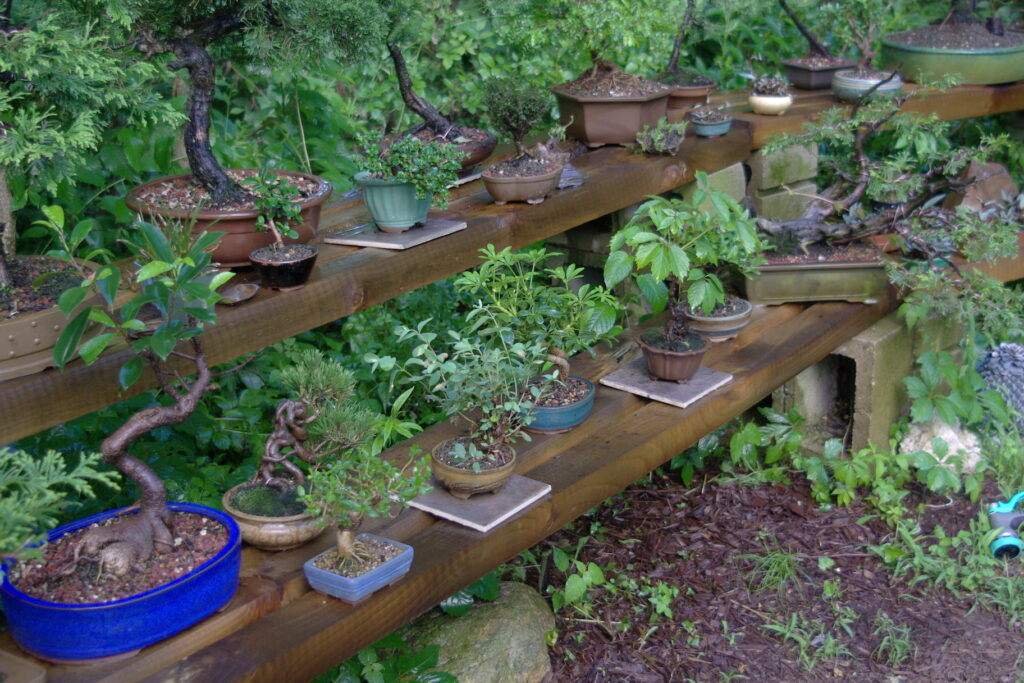
So if you are like me when I first started bonsai, by now you have participated in the demise of several junipers, have become frustrated and decided to do a little “proper prior planning” before your next attempt. Good for you!
In this article we will discuss some common mistakes beginning students make and offer some alternative approaches. We will provide some insight on selecting appropriate materials and how to work with them. We will even show you materials that can be used to create cool trees from your very back yard, local park or nearby wilderness area for free. Of course, if you are impatient you could go straight to the bonsai plants for beginners list at the end of this article.
Bonsai-focus for the long term.
At the onset of this article I need to point out the most common failing of beginning students aside from the lack of experience, and that is impatience. The art of Bonsai is long termed focus. You can’t repot, cut off branches, wire, and style a tree all in one sitting and expect it not to react negatively or even die. Would it surprise you to know something as simple conceptually as watering can take years to learn in bonsai culture?
Watering-is your tree drowning?
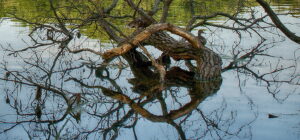
Watering
Over/under watering is at least in the top 3 causes for bonsai death especially with beginning students. Typically, it is a combination of poorly draining soil and over watering. The result is an anaerobic condition in the soil and the tree roots suffocate or more appropriately drown.
In a properly functioning watering system, the water will pass into and through the soil rather quickly this will draw in fresh air behind thus keeping the roots oxygenated while drawing in nutrients and providing hydration.
Poor watering symptoms;
- In general, poor tree health, loss of foliage, yellowing or browning of foliage.
- The young new shoots are wilting.
- Water runs off or just sits on the surface of the soil but doesn’t drain out of the bottom of the pot drainage holes.
When the student encounters this condition immediate action should be taken before permanent damage or loss of the tree occurs. Usually this requires re-potting of the tree in good well-draining bonsai soil or adjusting the watering cycle.
How do I know if I’m doing it correctly?
There is no foolproof way to determine over or under watering without having some experience or history with a specific tree. However, there are some techniques that can be used to give the student some indication prior to incurring permanent damage.
For example, water just sitting on the soil surface. This a good indicator of bad soil, Pot bound plants, or the soil is already saturated. So, further investigation would be required to determine a remedy.
Another technique I use is pot weight. With experience the student can develop a feel based on weight when the tree has enough moisture or is quite dry.
Start by thoroughly saturating your tree then lift the pot and get a feel for how heavy it is. Let it sit for 24 hours and before watering lift it again. Has there been a significant change? No Change? Let it sit for another day and recheck as above. If the tree needs water, you will start seeing it droop but that should coincide with a significant weight change.
If the tree is showing signs of ill health, drooping leaves but there is no weight change then it maybe you are over watering, Is the soil mud like? does it stink? not draining? Slime mold growing on the soil and tree?
The key “take away” is, don’t just react but dig in a little before you apply a solution.
Selecting the right material- “In-ny or out-y”
So, when looking for a cool tree to bring home as your first bonsai avoid those kiosks’s that pop up at your local mall’s. While some of these trees may be okay and survive the vast majority will be highly stressed, marginal in health and destined for the fire pit. The common term you will hear when discussing these sources are “Mall-sai”. Local specialty nurseries, Bonsai societies, plant shows are usually better resources to get material from. The additional advantage is the sellers can often provide detailed care instructions .
Inside or outside bonsai – which is best?
The real truth is there is no such thing, all bonsai or plants for that matter are outside plants. Most bonsai material needs to be outside for as long as possible to maintain health.
The designation comes from the plants ability to survive the climate where the student grows it. For example in New-England most tropical trees like Ficus.Sp will not survive our winters without protection. This would be considered an inside bonsai as they need to be brought in when the outside temperatures hit a certain threshold. However, all bonsai should be left outside for as long as conditions will allow.
Good bonsai plants for beginners.
Unfortunately it is impossible in the scope of this article to identify species that will work for everyone everywhere on the planet but this might provide some insight as to what works and the student can find something similar in their region.
I live in USDA plant zone 5-6 so the minimum average temperatures can range from 0 deg F to -20 deg F. The species covered here will survive in this zone.
Beginner trees – Still cool !
Ficus Sp. (fig)
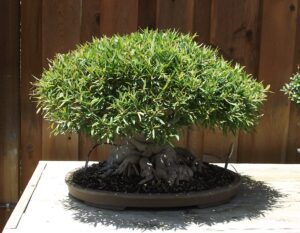
There are many species however some common varieties used for bonsai are; F. Benjaminia, F. Neriifolia, F. Religiosa, F. Retusa
Location: Indoors semi shade to full sun, Avoid locations with cold droughts as this can cause leaf drop temperatures should not fall below 15ºC.
Feeding: Feed only when showing active growth, Don’t feed during the winter months, when feeding use high nitrogen or balanced fertilizers
Watering: Normal
Care: Easy
Disease/pests: Black spot, Scale and Mites
Larix.Sp (Larch)
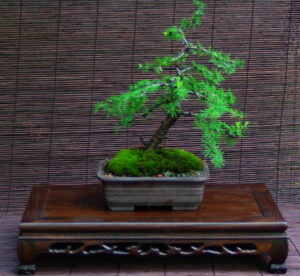 |  Bog Larch |
| Larch on the right after potting and styling | The same larch in its natural environment |
There are several Species both Japanese and American all are good subjects. The American variety is typically found in bog environments and is easy to collect early spring before bud swell or Fall just as the needles start to shed. These trees “swamp layer easily” I have collected old trees with no roots ant they have survived.
Location: Out door, Semi shade to full sun, They require no protection in winter unless temps drop below -20ºC, make sure the roots do not dry out.
Feeding: Feed heavily as soon as the buds begin to swell in spring with high nitrogen fertilizer continue through summer but cease around the last week of July through second week of August. Revert to low nitrogen fertilizers late summer and fall. Cease when the needles drop.
Watering: Normal, Keep evenly moist if trees are in direct sun check regularly, daily.
Care: Easy, avoid heavy root pruning when re-potting, do not bare root established trees. Wiring can be done in late winter or early spring before the buds swell.
Disease / Pests: Larch are relatively disease free watch out for Borers, Aphids and Scale especially with collected specimens.
Euonymous.Sp
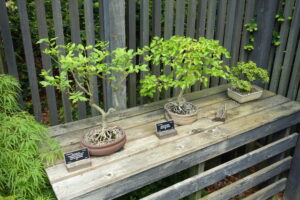
There are 175 varieties to choose from also known as winged spindle bush or burning bush. An outside tree this species has become an invasive, nuisance species in many communities and many of the New England nurseries no longer sell it. Fortunately for the bonsai enthusiast they are now found growing wild in low woodland area’s, flood plains. This species is easy to collect in spring or fall.
Location: Bright semi shaded area, a couple of hours of direct sunlight is permissible but health degrades quickly if set in direct sunlight continuously.
Feeding, every couple of weeks from spring to late summer
Watering: Normal, Keep evenly moist if trees are in direct sun check regularly, daily.
Care: easy
Disease / Pests: Mildew, Leaf spots
Lonicera. Sp
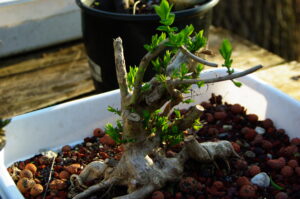
Collected stump
There are over 100 species of Lonicera, ( Honeysuckle) they range from climbing vines to small
shrubs. Plants easily regenerate from old wood. Responds well to trimming and light wiring. Bark develops aged bark quickly and muscles nicely. An outside plant but may require some protection in winter for plants in small pots. This plant can be found in old flood plains, river beds and shore lines. Old homesteads. Easy to collect in the spring, roots easily so minimum roots need to be taken.
Location: Full sun out door, keep evenly moist, this species may lose leaves and branches if it becomes too dry but will quickly regenerate once conditions become favorable. Small plants in small pots may require some protection below -5ºC
Feeding: Feed continuously during the growing season
Watering: Keep moist but not saturated.
Care: Easy, moisture needs to be monitored but will regenerate quickly if the plant dries out.
Note, if used as a small bonsai re-potting will need to be frequent as the roots grow quickly and the plant will become pot bound
Disease / Pests: relatively disease and pest free.
The following are some additional plants that you can be easily collect in your own back yard and have great potential for bonsai culture.
Parthenocissus tricuspidata (Boston Ivy)
Parthenocissus quinquefolia (Virginia Creeper)
Vaccinium.Sp (Blue berry)
Arctostaphylos uva-ursi (Bear berry)
Conclusion
There are a number of things that can be done to improve your success in keeping your trees healthy however learning the watering processes essential. Remember, all plants are outside plants gather all the facts on the growing conditions of the species before attempting to grow it. Chose varieties that will grow where you live this eliminates the need for creating a favorable growing environment like a hot house. Don’t overlook your own back yard for free material that will become good bonsai.
As always we welcome your comments please feel free to contact us if you need additional help
John.
BDB Bonsai
POST YOUR COMMENTS